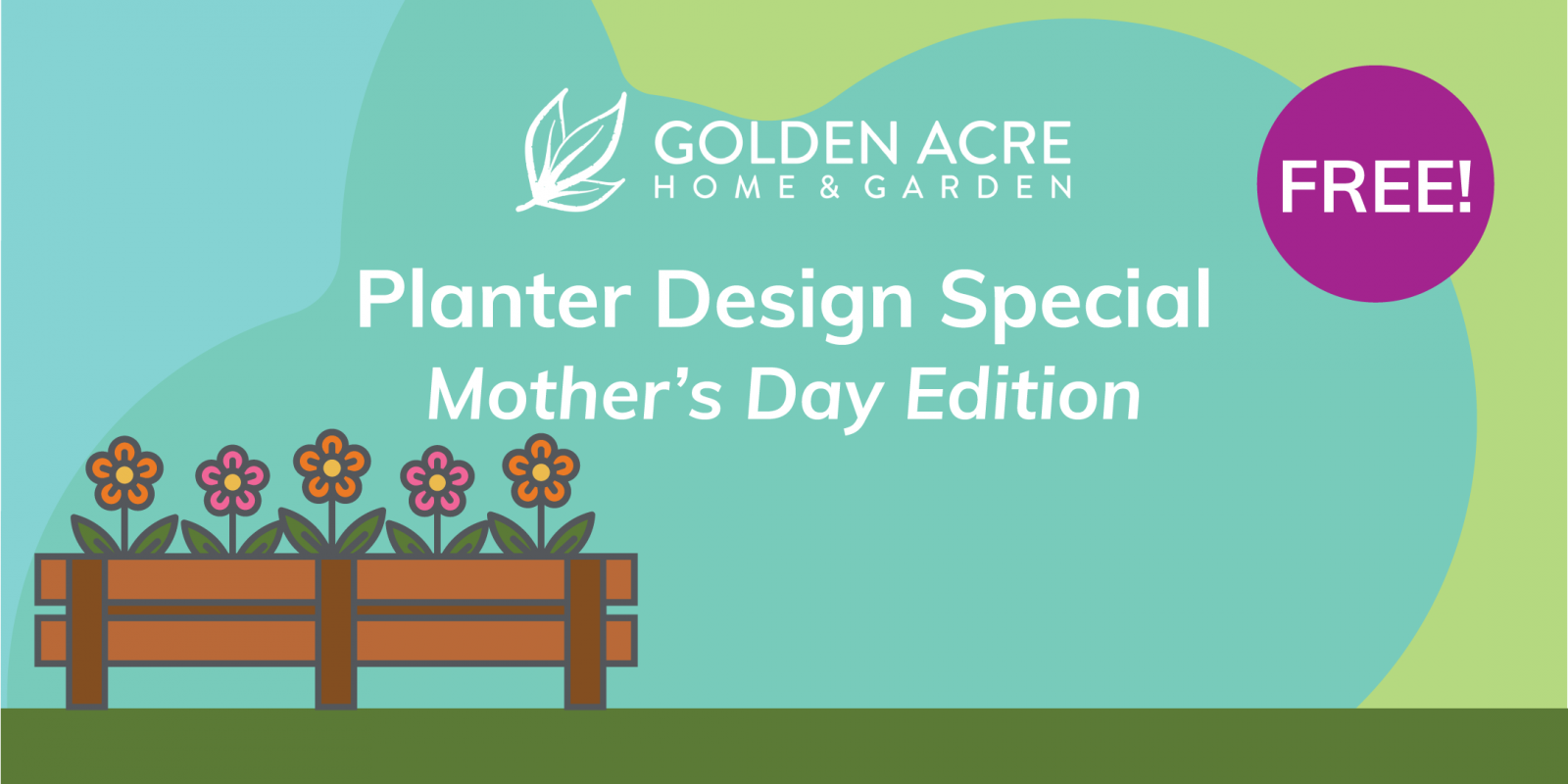Seasonal planters are fun to create and a beautiful addition to any patio, porch, or balcony that could use a little more colour. You can sit them on the ground, in a stand, hang them, and even use them to spruce up railing. Usually when we thinking of planters, we think flowers. I’d encourage you to think outside the box and consider growing veggies and herbs in plants. Why not mix all three! This is why planters are so great. They’re versatile and quite easy to care for. Don’t be afraid to take chances and get creative. Your planter can be small or grandiose, monotone or a rainbow of colour.
Planter s can also make great gifts! Get the kids involved! They can choose the plants and have fun playing in the soil. Read on to learn more about planters including how to design, plant, and care for them so they’ll last right through until the fall. The pollinators will thank you. The goal here is to make your next trip to the garden centre more focused, and the planting/enjoying part more fun!
Planning Considerations
Selecting a Pot
Aesthetically, you may change your mind a thousand times when selecting a pot. The important thing is to make sure your pot has a drainage hole at the bottom for excess water and how it will be viewed in your garden. Decide what purpose your planter will serve. Will it welcome visitors at your front door and need to be tall and showy? Will it be seen on a main stairway and need to be round to avoid harm? Is it the main event on your patio table and need to be wide so it can hold a lot of plants? Do you have a hook that can only accommodate a certain weight of a hanging basket?
Drainage Hole
This is so important. A build up of water in the bottom of the pot can lead to disease, like root rot. Luckily, most planter pots come with a drainage hole at the bottom.
Size
Think about how tall and wide your pot needs to be. If you’re looking for a statement planter to live at your entryway, then you may need something quite tall. I love entryway planters because you can utilize them in every season by changing out the flowers for grass or winter greens. However, you don’t want to fill the entire planter with soil because that would be a waste of time and money. Annuals roots don’t need much for the growing season, so here’s a tip. Fill the bottom with Styrofoam from the hardware store, and place it at the bottom of the pot as filler. Then, add soil on top of that or purchase a pre-made planter and insert it on top annually. If you’re looking at adding a hanging basket, consider the weight of that planter when it’s fully watered. Will your hook withstand the weight?
Material
Pots can be made out of wood, ceramic, fiberglass, coconut coir, terracotta, and even a repurposed toilet! Yes, feel free to get creative with even the vessel of your planter. Be mindful that some materials will require different habits. For example, terracotta can be tricky in dry climates like Calgary because it’s made to draw water out of the planter. You may need to commit to more watering, and you may need to put it away earlier in the autumn so the seasonal shift doesn’t break it. Also, think about how heavy your planter will be once there’s soil and flowers in it. Ceramic can be heavier than wood pots.
Maintenance
Although planters typically have less weeding requirements, you still need to be able to water, fertilize, and deadhead it. If it’s in a hard to reach area, you may forget it, or may not be able give it proper maintenance. See below for more maintenance tips.
Reduce, Reuse, Recycle
We had a great question at the webinar about reusing pots from previous years. YES, YOU CAN! Empty out the old soil and wash your pots to remove any pests and start fresh. You can use existing soil, but make sure to amend it by adding in nutrients. Flowers and veggies are high production plants, so they need a bit of sustenance. Use fresh potting mix or lighter products like peat moss and worm castings.
Selecting Plants
Examples of Annual flowers & veggies
Always consider sun exposure when selecting plants. How much sun and weather will your planter be exposed to? Here are some examples of plants and don’t be scared to mix and match veggies with florals.
- Flowers
- Sun Lovers | Marigolds, Petunias, Osteospermum, Portulaca, Million Bells, Zinnia
- Shade Lovers | Begonia, Impatiens, Geranium, Bacopa, Creeping Jenny, Fuchsia
- Veggies
- Sun Lovers | Tomatoes, Strawberry, Cucumber, Peppers,
- Shade Lovers | Kale, Lettuce, Spinach, Arugula
- Herbs
- Sun Lovers | Basil, Lavender
- Shade Lovers | Chilves, Dill
Selecting Plants
- Thriller | The showstopper that will tower above the rest… Geranium, Lavender, sunflower, tomato, dill, etc.
- Filler | “Filling” the middle of the pot… Petunia, marigold, strawberry, thyme, etc.
- Spiller | These will “spill” over the side of your pot…Bacopa, Creeping Jenny, grasses, etc.
Going back to your pot and purpose… how will this be viewed? If you have a hanging basket, you may want to focus on fillers and spillers that will trail down. If you have a planter sitting on your patio, you may want to invest in those showy plants like Geranium.
How many do you need though? This is always dependent on the size of the planter and how you’ll display the plants. In today’s webinar, Colin stuffed that floral planter full with the intention that he was going to maintain and deadhead it. If you’re unsure, try placing them in the pot while your shopping to get a rough idea. Colin used 6 types of plants for his 16″ planter. If you’re still unsure though, always ask the team at your local garden centre for advice.
Note: In colder climates, like Calgary, it’s not advisable to plant perennials in pots. If you’re only expecting to enjoy them for one year, then these will work great, but it’s very difficult to over winter them. If you dig them up and store them inside over the winter, then they’ll suffer root shock a couple times a year, and may not get that needed dormancy period they’d normally receive outdoors. Some gardeners have had luck with planting the pot in soil outdoors over the winter which is an option, but it’s a lot of work and may damage the pot.
Planting Planters
How to Plant
- Gather materials in your workspace. Things will get messy! If you have a heavy pot, consider planting in the place where it will live so you don’t need to move it.
- Start by filling your pot a couple inches with soil as a base. Tamp is down, but don’t compact it. Roots need to be able to move and breathe. Use a general potting mix or amended existing soil as mentioned above
- Layout where your plants will go.
- Assuming you have a “thriller” plant, make a hole the size of the pot and gently remove the pot. Be mindful of delicate roots. Place plant in hole and backfill to rootball level. Don’t worry about tickling the roots or cutting them. This is an optional step and should be done carefully to protect those delicates babies.
- Next, plant your “filler” plants, and work outward from there for your “spiller” plants until the pot is full. It’s okay to have leftover plants.
- Once all plants are in, water, fertilize, and enjoy. See below for tips.
Maintaining Planters
Watering
Check regularly and water as needed. Early morning is the best time to water. Overwatering can lead to root rot and other various pathogens. Caution on weeks where there’s a lot of rain. You may need to cover or transport planters elsewhere. On the flipside, underwatering can lead to poor production of fruits and flowers. On those super hot days, you may need to water 2 or 3 times a day. May sure water is reaching the soil and not just the leaves so the roots have access to it. This is especially important as foliage grows to cover the soil surface.
It’s always a good idea to start a fertilizer program with your annual planters so they’ll continue to produce until the fall. Fertilizer is essential for some plants, like tomatoes, that are susceptible to pathogens like blossom end rot. For most planters, you can use an all purpose fertilizer, or get specific if you’re growing flowers or veggies. Try to avoid a high nitrogen product and always follow manufacturers directions. Too much fertilizer and you can risk burning the roots. Water soluble is a great option for annuals because you can fertilizer while watering. However, slow-release works well too if you have a busy schedule and need a “set it and forget it” option.
- All Purpose Fertilizer | LINK
- Slow-release All Purpose Fertilizer | LINK
- Tomato Fertilizer (Calcium for blossom end rot) | LINK
- Flower Fertilizer | LINK
Deadheading
Deadheading is the removal of finished blooms to help the plant redirect energy into producing more flowers. This should only be done with annual flowers and herbs. Don’t deadhead fruits and veggies because that’s where all the magic happens. Deadheading can help stretch your planters into the autumn and help support pollinators. Plus, planters just look better when finished blooms are removed! The idea is to remove the seed pod, so snip away the bloom and discard into the compost.
Resources
More Detailed PowerPoint Presentation | GA Webinar – Planters
Encore Webinar Video | Coming Soon
Our Podcast | The Helpful Gardeners Podcast (New Episodes Sunday 8am MT)
Next Webinar
Transplanting, Seeds, and Garden Check up | May 20, 2023



